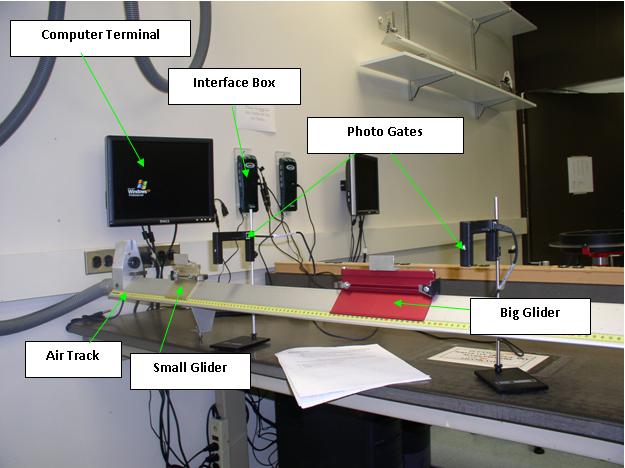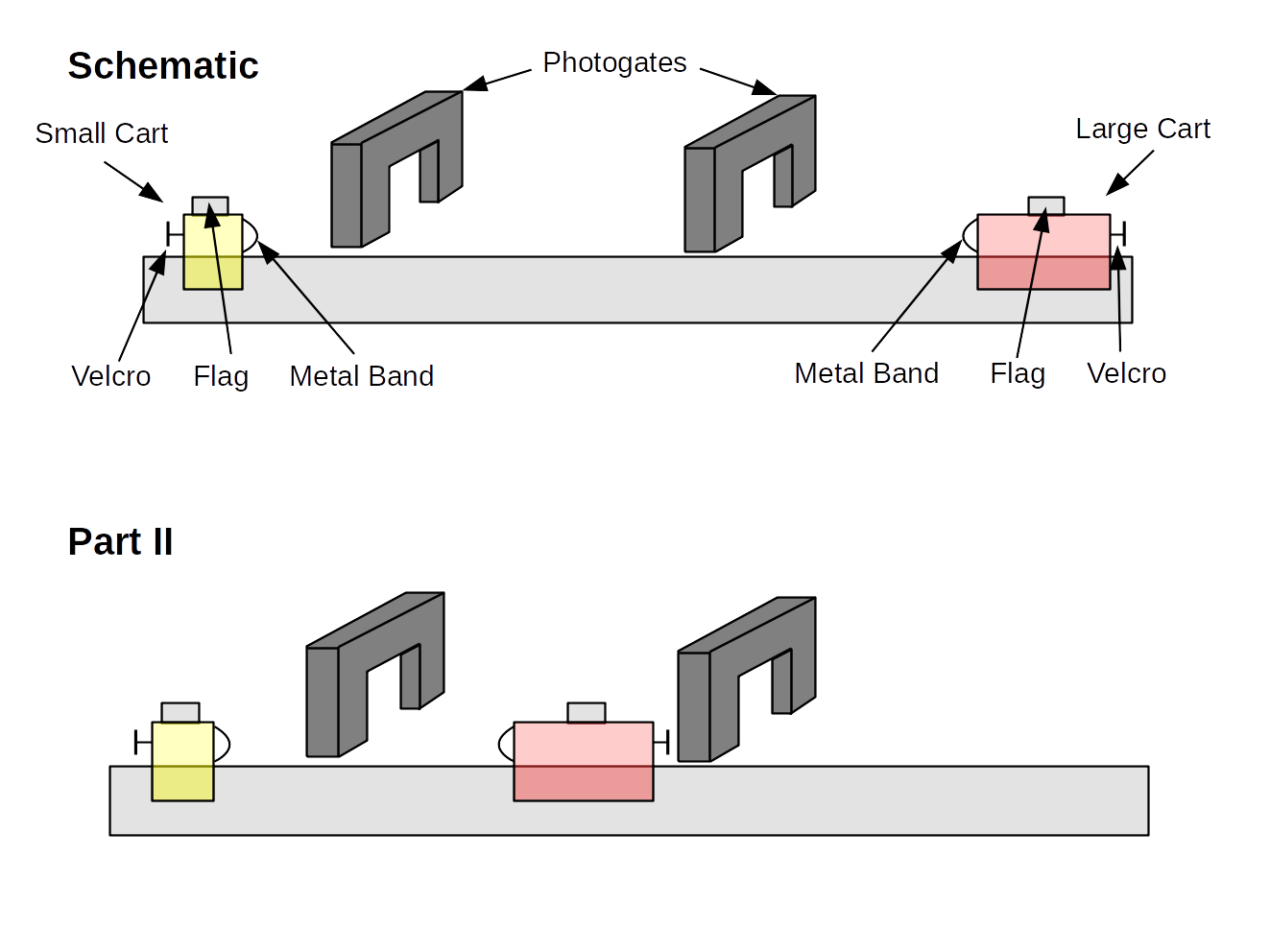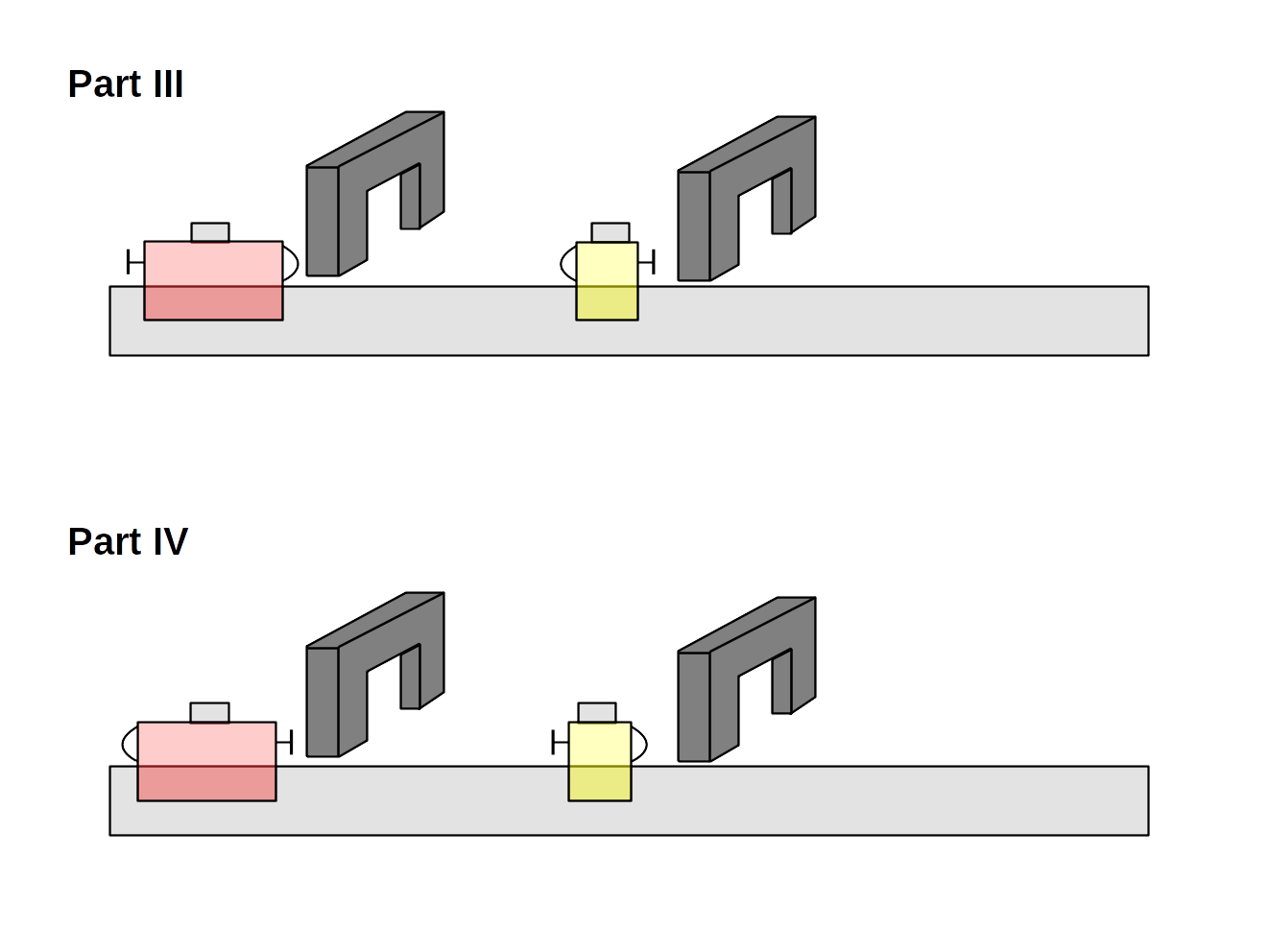
Conservation of Momentum

In this lab, we will study the principles of conservation of momentum and energy in a variety of collisions.Hoveroverthese!
- 1 Air Track Setup
- 1 Air Track (attached to air pump)
- 1 Large Cart w/ Flag
- 1 Small Cart w/ Flag
- 2x Photogate Setup
- 1 Meter Stick
- Access to a Scale
- Record data in this Google Sheets data table
Suppose you have a cart of mass \(m_1\) and velocity \(v_{1i}\) colliding with a cart of mass \(m_2\) and velocity \(v_{2i}\), with motion confined to one dimension.1
If the collision is perfectly elastic, then both momentum and energy are conserved. In this case, the final velocities of the carts are the following:
$$v_{1f}=\frac{m_1-m_2}{m_1+m_2}v_{1i}+\frac{2m_2}{m_1+m_2}v_{2i}\label{ElasV1}$$ $$v_{2f}=\frac{2m_1}{m_1+m_2}v_{1i}-\frac{m_1-m_2}{m_1+m_2}v_{2i}\label{ElasV2}$$If the collision is totally inelastic, then only momentum is conserved; energy is lost 1. In this case, the carts end moving together with one common final velocity:
$$v_f=\frac{m_1}{m_1+m_2}v_{1i}+\frac{m_2}{m_1+m_2}v_{2i}\label{Inelas}$$In this lab, we will focus on validating the conservation laws themselves (since the above results follow from those conservation laws).
Part I: Preliminary Setup and Measurements
Level your air track, as described in the Air Track Reference Manual (and as you did in the previous lab).
Open the LoggerPro file "ConservationofMomentum" 1 and connect your two photogates, as described in the Photogate Reference Manual.
Measure the mass of both your carts. Measure the width of both carts' flags. Estimate uncertainties in both quantities.
Place the cars on the air track, and the photogates at two different positions along the air track. Ensure that the photogate is high enough that as the carts pass through the photogate, only the flag on top sets off the photogate, not the whole cart.2
Identify which photogate is photogate 1 and which one is photogate 2 by blocking one and seeing which one registers as blocked.
In each of parts II-IV, we will be aligning the air track as follows:


Part II/III/IV: Colliding Two Carts
For each part, do the following:
Set up the two carts and the photogates on the air track as shown in the diagram above.
Press "Start Collection" on the computer, and give the program a second to start recording.
Push the cart outside the photogates lightly (but not too lightly) towards the center. Make sure you are not still pushing it by the time it begins to cross the photogate.
The carts will collide and bounce back. Catch them after they each past the photogate once post-collision.3
The photogates will record a variety of times. They come in pairs: for each photogate, for each cart that crossed in front of it, there is a time when the flag began to cross it and a time when the flag finished crossing it. The difference between these times is \(\delta t\), the time it took the flag to cross it.
Take note of which pairs of times correspond to which crossings of the photogate (knowing which photogate is which should help you here). Record the corresponding differences in times in your data table. Also take note of what directions the carts were moving, initially and finally.
For each collision, do the following:
- Calculate velocity, momentum, and kinetic energy for each cart. Propagate uncertainties.
- Calculate total initial and final momenta and kinetic energies. Propagate uncertainties.
- State whether momentum and energy were conserved, and whether you expected them to be.
Your TA will ask you to discuss some of the following points (they will tell you which ones):
- Formula derivations:
- Elastic: Based on the quantities you know are conserved in such collisions, derive the formulas for the final velocity of the carts in elastic collisions, \eqref{ElasV1} and \eqref{ElasV2}.
- Inelastic: Based on what you know of totally inelastic collisions, derive the formula for the final velocity of the carts in inelastic collisions, \eqref{Inelas}.
- Dimensionless formulas:
- Elastic: Beginning with formulas \eqref{ElasV1} and \eqref{ElasV2}, using the dimensionless parameter \(\lambda=\frac{m_2}{m_1}\) instead of the masses, show that: $$v_{1f}=\frac{1-\lambda}{1+\lambda}v_{1i}+\frac{2\lambda}{1+\lambda}v_{2i}\label{ElasV1Dimless}$$ $$v_{2f}=\frac{2}{1+\lambda}v_{1i}-\frac{1-\lambda}{1+\lambda}v_{2i}\label{ElasV2Dimless}$$
- Inlastic: Beginning with formula \eqref{Inelas}, in terms of the dimensionless parameter \(\lambda=\frac{m_2}{m_1}\) instead of the masses, show that: $$v_f=\frac{1}{1+\lambda}v_{1i}+\frac{\lambda}{1+\lambda}v_{2i}\label{InelasDimless}$$
- Special Cases:23
- Initially Stationary Cart: Suppose the second cart is initially stationary, \(v_{2i}=0\), and the first cart comes in with a velocity \(v_{1i}=v\). What are \(\frac{v_{1f}}{v}\) and \(\frac{v_{2f}}{v}\) in each of the following cases?
Type of Collision \(m_1=m_2\) \(m_1\gg m_2\) \(m_1\ll m_2\) Elastic ? ? ? Inelastic ? ? ? - Head-On Collision: Suppose the two carts collide with velocity \(v\), \(v_{1i}=v\) and \(v_{2i}=-v\). What are \(\frac{v_{1f}}{v}\) and \(\frac{v_{2f}}{v}\) in each of the following cases?4
Type of Collision \(m_1=m_2\) \(m_1\gg m_2\) Elastic ? ? Inelastic ? ?
- Initially Stationary Cart: Suppose the second cart is initially stationary, \(v_{2i}=0\), and the first cart comes in with a velocity \(v_{1i}=v\). What are \(\frac{v_{1f}}{v}\) and \(\frac{v_{2f}}{v}\) in each of the following cases?
- Systemic Error: Track Bowing You may have found that couldn't perfectly level the air track: if it was level in one place, it was not quite level in another. This is because the air tracks are supported on the ends, and over time, the air track becomes bowed: the middle of the air track sags a bit. Recall that we usually level the air track so that it's flat in the middle (thus higher on the ends), and discuss this impact as a systemic error: what impacts would it have on conservation of momentum? Of energy? What if we ran a slightly different experiment, with a more head-on collision instead of one cart stationary in the center?
Hovering over these bubbles will make a footnote pop up. Gray footnotes are citations and links to outside references.
Blue footnotes are discussions of general physics material that would break up the flow of explanation to include directly. These can be important subtleties, advanced material, historical asides, hints for questions, etc.
Yellow footnotes are details about experimental procedure or analysis. These can be reminders about how to use equipment, explanations of how to get good results, or clarifications on details of frequent confusion.
For an understanding of collisions in one dimension (elastic and inelastic), see Katz, Chapters 8,10,11 (especially sections 11.4, 11.5). In Giancoli, refer to Chapters 8, 9 (especially sections 9.5,9.6).
The older LoggerPro file "Exp5_t1_t2" will also work.
Beware, in particular, the little screws on top of the cart: if the photogate sees these, you'll get extra times as the screw passes through, which can be confusing.
We want to pretend our air track is infinitely long, without ends; so we don't want them rebounding off the end and colliding again (as the point is that there's no collision with the "outside world," of which the air track end is part!)
That is, some kinetic energy is lost. An aspect of the colision is non-conservative and some energy is converted into thermal energy or another form.
Hint: there are three special values of \(\lambda\) one can use in equations \eqref{ElasV1Dimless}, \eqref{ElasV2Dimless}, and \eqref{InelasDimless}: \(0\), \(1\), and \(\infty\) (with the first and last being limits, not exact values), and these are the special cases we examine here.
Your answers should not be \(0\) unless the expression is exactly zero. If the answer is "approximately but not exactly" zero, you should be able to calculate that the ratio is approximately a constant multiple of \(\lambda\). You should compute what this ratio is; i.e., your answer should be of the form: \(\frac{v_1}{v}\simeq 2\lambda\) (or something like that). Otherwise, you should not need to use the masses or \(\lambda\) in your approximate expressions.
Note \(m_1\ll m_2\) is the same as \(m_1\gg m_2\) by symmetry, just in the opposite direction, which is why we don't consider it as another special case.